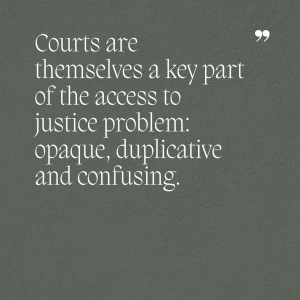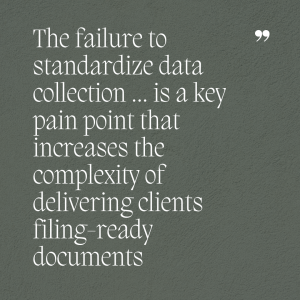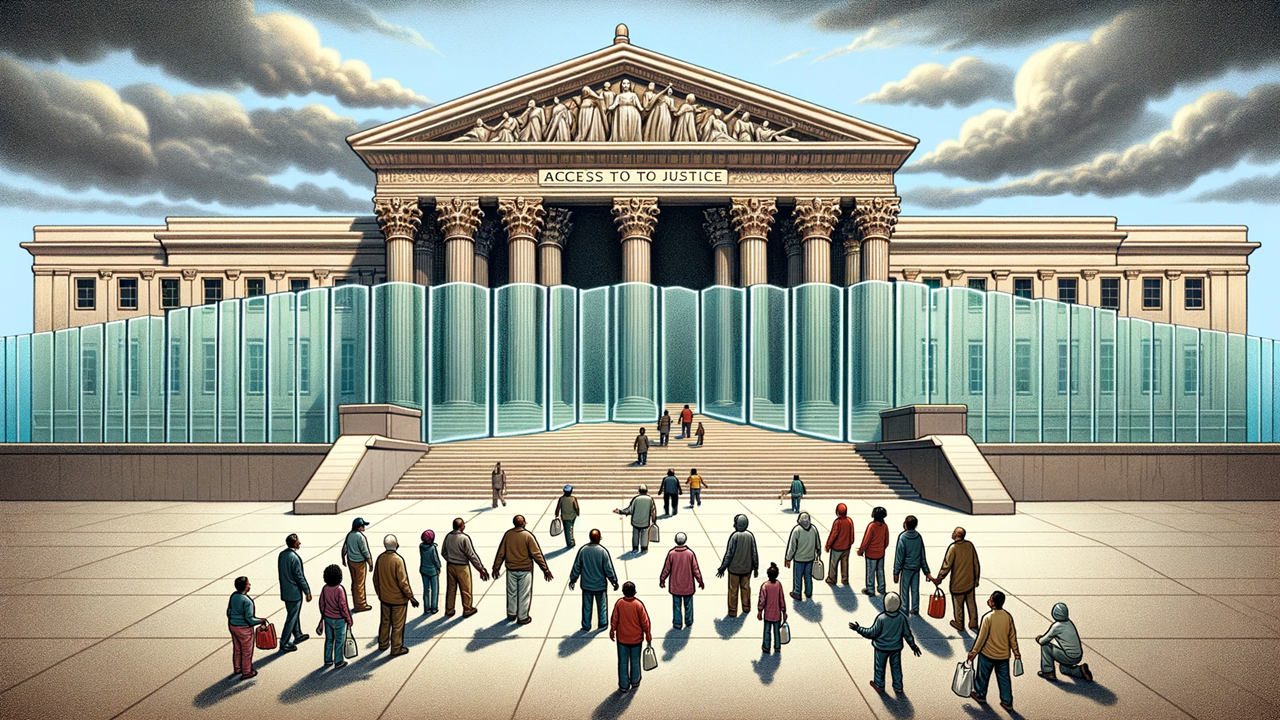Editor’s note: The following guest post is a response to my recent post, The Justice Gap in Legal Tech: A Tale of Two Conferences and the Implications for A2J. It is written by Mark Chandler, former chief legal officer at Cisco Systems from 2001- 2021 and now a lecturer in law at Stanford Law School and a fellow at the Stanford’s Deborah L. Rhode Center on the Legal Profession, where he helps lead the Filing Fairness Project, and Jess Lu, a third year law student at Stanford and a civil justice fellow at the Rhode Center, who was formerly a senior associate consultant at Bain & Co.
By Jess Lu and Mark Chandler
On the first Earth Day in 1970, cartoonist Walt Kelly created a poster proclaiming, “We have met the enemy, and he is us.” This observation applies manifestly to our court systems: an inefficient and complicated civil justice system has become its own greatest enemy, frustrating its very purpose of providing access to civil justice for all.
Bob Ambrogi recently contrasted the efficiency and elegance of legal-tech tools available in the corporate sector with those designed for the civil justice system. While Bob correctly pointed to systematic underinvestment in legal tech tools for civil justice as one cause, it’s a second order cause at best: funding alone will not close the gap. Justice tech — legal tech that helps low-income folks with no or some ability to pay, that assists the lawyers who serve those folks, and that makes the courts more efficient and effective — must contend with a higher hurdle than wooing Silicon Valley VCs: the civil justice system itself.
 A checkerboard of technology systems and data infrastructures across thousands of local court jurisdictions makes it nearly impossible to develop tools with the scale needed to be sustainable. Courts are themselves a key part of the access to justice problem: opaque, duplicative and confusing court forms and burdensome filing processes make accessing the civil justice system deeply inefficient for the sophisticated, and an impenetrable maze for the 70+% of civil litigants who don’t have a lawyer.
A checkerboard of technology systems and data infrastructures across thousands of local court jurisdictions makes it nearly impossible to develop tools with the scale needed to be sustainable. Courts are themselves a key part of the access to justice problem: opaque, duplicative and confusing court forms and burdensome filing processes make accessing the civil justice system deeply inefficient for the sophisticated, and an impenetrable maze for the 70+% of civil litigants who don’t have a lawyer.
The current patchwork of localized justice tech developed largely on a one-off basis to solve legal problems piecemeal is likely doomed. A 2019 study by the American Bar Association of client-facing legal tech characterized these tools as “new technologies [that] are born and die almost daily.” A 2023 study by the Duke Center on Law & Tech found that “justice tech” struggles to “find sustainable business models that also expand access to justice” and that “[t]raditional funding models fall short.”
If courts move to standardize the collection of “data” (i.e., the information typically submitted on forms) and the electronic-filing systems that transmit information to the courts, they can create a viable market for end-to-end tools that could provide sustainable, scalable justice tech. Stanford Law School’s Filing Fairness Project which has partnered with state and local court systems and officials in Alaska, California, Colorado, Kansas, Michigan, Texas and Virginia, has helped establish the conditions necessary for the development of sustainable, multistate solutions to filing problems. This will benefit everyone: judges, court staff, lawyers, legal aid organizations, justice tech, and the public.
And then the necessary investment will happen. But in order to reap those benefits, two things must occur.
Standardize forms or replace forms with guided interviews
First, patchwork systems create jurisdictional differences not required by statute in the way data is collected for courts (usually via forms), and in the systems — both front-end and back-end — that are necessary for signature, payment and filing. And forms often change with little or no warning to litigants who may be operating on old information. The failure to standardize data collection (and court forms are, fundamentally, little more than data collection tools) is a key pain point that increases the complexity of delivering clients filing-ready documents. For the tax system, the IRS and the states agreed on standardization that made it straightforward to develop software to automate the data collection process.
 Such standardization is entirely absent from the civil justice system. Court documents not only vary widely from court to court, but also within a court itself. For instance, in the heart of Silicon Valley, the San Mateo Superior Court’s self-help portal for self-represented litigants lists the 30 forms a litigant might need when filing a civil restraining order. The official California Judicial Council self-help site for abuse victims seeking a domestic violence restraining order states: “You may not need all of these forms. Or you may need more forms … All California courts use the same basic set of forms. But some courts have special, local forms, too. To see if you will need any special, local forms, contact your court clerk or check your court’s website.” Not only is there no standardization, there is no official guidance on what forms are required. Ordinary folks cannot navigate the civil justice system without a trained guide; yet ordinary folks can’t afford a trained guide. And in many situations, including when filing restraining orders, they shouldn’t need one.
Such standardization is entirely absent from the civil justice system. Court documents not only vary widely from court to court, but also within a court itself. For instance, in the heart of Silicon Valley, the San Mateo Superior Court’s self-help portal for self-represented litigants lists the 30 forms a litigant might need when filing a civil restraining order. The official California Judicial Council self-help site for abuse victims seeking a domestic violence restraining order states: “You may not need all of these forms. Or you may need more forms … All California courts use the same basic set of forms. But some courts have special, local forms, too. To see if you will need any special, local forms, contact your court clerk or check your court’s website.” Not only is there no standardization, there is no official guidance on what forms are required. Ordinary folks cannot navigate the civil justice system without a trained guide; yet ordinary folks can’t afford a trained guide. And in many situations, including when filing restraining orders, they shouldn’t need one.
Once data collection is standardized, a lawyer or litigant need not figure out what forms are required and fill out individual, often duplicative forms. Instead, they can answer plain-language questions that standardize and automate a large portion of client intake. Think of self-help tax products like TurboTax: the software asks simple questions that users with little tax knowledge can answer. While such legal tools exist now in some narrow areas — for example, Upsolve’s free bankruptcy tool or the Tenant Power Toolkit in California — they can be expanded to serve more jurisdictions. The Tenant Power Toolkit is currently limited to California eviction cases: users fill out California-specific eviction forms, but then use separate e-filing through One Legal, a California-specific e-filing tool. Tellingly, Upsolve limited itself to bankruptcy because of the relative uniformity of data collection thanks to having one, national bankruptcy code.
Standardize filing
Second, even if data collection is simplified, the systems for filing cases in court — in other words, delivering the “data” in a form the court can use — are almost equally disjointed. For example, self-represented litigants cannot e-file at all in eight states and, even where they can, they can only e-file in a limited set of case types. Some states still require “wet signatures,” and there is no standardization of fee payment systems. Some courts refuse to provide visibility on their website into tools for filing built by private-sector companies, impeding adoption.
This combination of system complexity and access barriers means that most justice tech does not help lawyers or litigants e-file the documents they prepare. And asking users to e-file on their own is a tall task. Even in states that permit self-represented litigants to e-file, only twenty-three incorporate fee waiver requests and only seven accommodate cash-paying e-filers; others require litigants to pay electronically using a credit card or bank transfer.
E-filing systems are not designed for user simplification. And they do not incentivize adoption. The Colorado courts charge additional fees to use their e-file system, including separate fees to e-serve documents. Their FAQs inform users: “Can’t afford fees? You will not be able to use this system. You will need to file your documents in person or by mail. Additional forms are required.”
Focusing on the funding gap between corporate tools and those designed for civil justice risks placing the horse before the cart. The filing fairness problem — complex, incongruous, and confusing jurisdictional requirements that vary state to state and even courthouse to courthouse — creates a huge barrier to development of simplified systems. Lawyers, including legal aid lawyers, and the courts themselves are needlessly rendered far less efficient. An end-to-end and seamless system, built around a standardized approach to court automation, can fix this.
No amount of funding can solve what is, at the end of the day, a problem of court modernization and standardization. The civil justice system is its own worst enemy. Once we standardize and simplify filing, innovation will come.
 Robert Ambrogi Blog
Robert Ambrogi Blog

